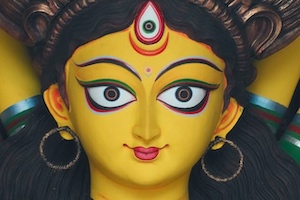Three-Century-Old Ananda Bhairavi Temple at Balagarh Upholds the Glorious Past of Bengal**
The Statesman | 20 October 2025A teacher of Balagarh Bijoykrishna Mahavidyalaya and a researcher on regional history, Partha Chatterjee, elaborates on Sukharia village, the then-prominent zamindar family Mitra Mustafi, and their glorification of traditional art and architecture. The family traces its ancestry to Kalidas Mitra, a Kayastha migrant from Kannauj. Rameshwar Mitra, a descendant, served under Emperor Aurangzeb and received the title ‘Mustafi’ along with a golden royal seal. Later generations settled in Sukharia, leaving behind an enduring architectural legacy.
The Ananda Bhairavi Temple, located in the village of Sukharia between Balagarh and Somra Bazar railway stations in Hooghly district, houses the idol of Anandamoyee Kali, the presiding deity. She is flanked by two identical rows containing six temples each.
Built in 1813 by Bireswar Mustafi, the Ananda Bhairavi Temple is a four-storey, twenty-five-pinnacled shrine. Its twelve smaller temples, intricate terracotta panels, and depictions of Krishna, Ganesha, Shiva, and scenes of elite social life illustrate Bengal’s rich temple traditions. Festivals during Shivaratri and Diwali remain major local celebrations.
The layout of the temple complex is particularly interesting: there are six temples on either side of the main shrine. Five of these are ‘atchala’ (eight-roofed) temples, while one is designed in the ‘pancharatna’ (five-pinnacled) style.
Nearby stands Radhakunj, the family’s palace-like residence, which once hosted jatra, kavigan, and theatrical performances. In 1979-80, filmmaker Mrinal Sen shot his film Akaaler Sandhane here, capturing the essence of the village’s heritage. Other temples, such as Harsundari Kali and Nistarini Kali, reflect colonial influences and grandeur, though many structures have suffered damage from earthquakes and neglect.
The Mitra Mustafi family continues to support the upkeep of the temples, an orphanage, and a charitable hospital. During Durga Puja, the village comes alive with rituals, birdsong, and the rhythmic hum of handlooms — connecting the past with the present.
Sukharia may appear quiet, but it remains a living testament to Bengal’s enduring roots — where history, devotion, and community spirit continue to thrive, said Mr Chatterjee.
